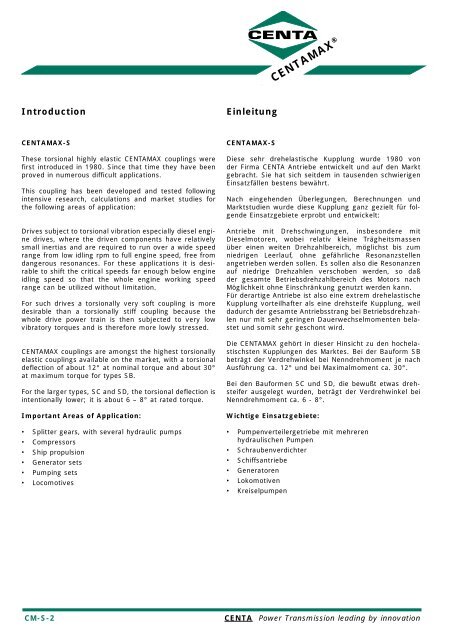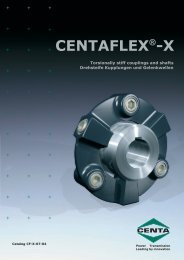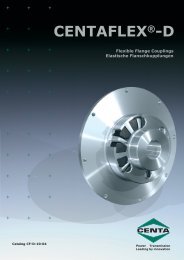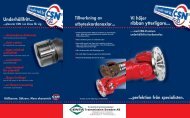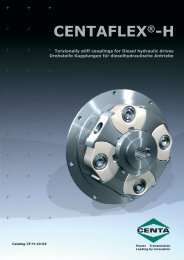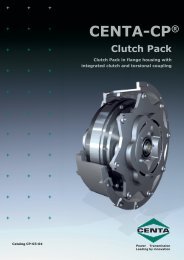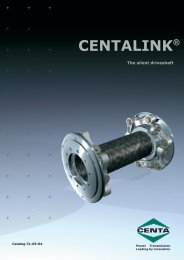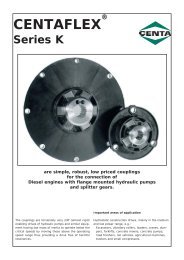centamax - CENTA Power Transmission - Sweden
centamax - CENTA Power Transmission - Sweden
centamax - CENTA Power Transmission - Sweden
Erfolgreiche ePaper selbst erstellen
Machen Sie aus Ihren PDF Publikationen ein blätterbares Flipbook mit unserer einzigartigen Google optimierten e-Paper Software.
<strong>CENTA</strong>MAX ®IntroductionEinleitung<strong>CENTA</strong>MAX-SThese torsional highly elastic <strong>CENTA</strong>MAX couplings werefirst introduced in 1980. Since that time they have beenproved in numerous difficult applications.This coupling has been developed and tested followingintensive research, calculations and market studies forthe following areas of application:Drives subject to torsional vibration especially diesel enginedrives, where the driven components have relativelysmall inertias and are required to run over a wide speedrange from low idling rpm to full engine speed, free fromdangerous resonances. For these applications it is desirableto shift the critical speeds far enough below engineidling speed so that the whole engine working speedrange can be utilized without limitation.For such drives a torsionally very soft coupling is moredesirable than a torsionally stiff coupling because thewhole drive power train is then subjected to very lowvibratory torques and is therefore more lowly stressed.<strong>CENTA</strong>MAX couplings are amongst the highest torsionallyelastic couplings available on the market, with a torsionaldeflection of about 12° at nominal torque and about 30°at maximum torque for types SB.For the larger types, SC and SD, the torsional deflection isintentionally lower; it is about 6 – 8° at rated torque.Important Areas of Application:• Splitter gears, with several hydraulic pumps• Compressors• Ship propulsion• Generator sets• Pumping sets• Locomotives<strong>CENTA</strong>MAX-SDiese sehr drehelastische Kupplung wurde 1980 vonder Firma <strong>CENTA</strong> Antriebe entwickelt und auf den Marktgebracht. Sie hat sich seitdem in tausenden schwierigenEinsatzfällen bestens bewährt.Nach eingehenden Überlegungen, Berechnungen undMarktstudien wurde diese Kupplung ganz gezielt für folgendeEinsatzgebiete erprobt und entwickelt:Antriebe mit Drehschwingungen, insbesondere mitDieselmotoren, wobei relativ kleine Trägheitsmassenüber einen weiten Drehzahlbereich, möglichst bis zumniedrigen Leerlauf, ohne gefährliche Resonanzstellenangetrieben werden sollen. Es sollen also die Resonanzenauf niedrige Drehzahlen verschoben werden, so daßder gesamte Betriebsdrehzahlbereich des Motors nachMöglichkeit ohne Einschränkung genutzt werden kann.Für derartige Antriebe ist also eine extrem drehelastischeKupplung vorteilhafter als eine drehsteife Kupplung, weildadurch der gesamte Antriebsstrang bei Betriebsdrehzahlennur mit sehr geringen Dauerwechselmomenten belastetund somit sehr geschont wird.Die <strong>CENTA</strong>MAX gehört in dieser Hinsicht zu den hochelastischstenKupplungen des Marktes. Bei der Bauform SBbeträgt der Verdrehwinkel bei Nenndrehmoment je nachAusführung ca. 12° und bei Maximalmoment ca. 30°.Bei den Bauformen SC und SD, die bewußt etwas drehsteiferausgelegt wurden, beträgt der Verdrehwinkel beiNenndrehmoment ca. 6 - 8°.Wichtige Einsatzgebiete:• Pumpenverteilergetriebe mit mehrerenhydraulischen Pumpen• Schraubenverdichter• Schiffsantriebe• Generatoren• Lokomotiven• KreiselpumpenCM-S-<strong>CENTA</strong> <strong>Power</strong> <strong>Transmission</strong> leading by innovation


